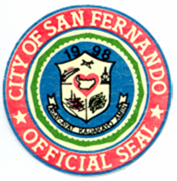Project Background
The Project site contains approximately 90 homes, the majority of which are occupied by informal settlers. Greywater (from sink, floor, and shower drains), septic tank effluent, and wastewater dumped directly from toilets flow into combined stormwater canals which empty into the Catbangen Creek, shortly before it reaches the South China Sea. There are numerous shallow wells along the drainage canals at risk of being contaminated, and residents often use the river for bathing, so improving the sanitation of this area is a high priority for the city. A location for the installation of EcoTanks has been identified near where one of the combined stormwater - wastewater drainage discharges to the river, and local residents seem eager for a solution to this problem. The importance of the project as well as the local interest indicates this may be an ideal location for a demonstration of effective sewerage management.
Combined Sewerage. A common scenario in the Philippines is that stormwater is allowed to mix with sewage in surface drains that flow to the nearest estero, river, or bay. There is often one such drainage behind every row of houses, with multiple discharge points to surface waters. Some discharges flow from homes through pipes to the drainage, but others seep from bottomless septic tanks as non-point sources of pollution. This combination of issues makes it very difficult to install fully piped sewer systems in existing housing areas. One solution, as detailed here, is to intercept the combined discharge and deliver it to a treatment plant for proper treatment prior to discharge to the river. Such "interceptor" sewerage systems catch the wastewater flow in a tank, and then pump the dry-weather flow to the treatment plant. During storms, interceptor tanks are designed to overflow so as not to inundate the wastewater treatment plant. As the overflow occurs during rainy periods, wastewater is diluted so impact to the environment is minimized. In some instances, interceptors are designed to capture and deliver more than just the dry-weather flow. Multiples of 1.25, 1.5 and up to 3 times the dry weather flow are common. For the Catbangen Phase 1 interceptor project, a multiple of 1.25 times the dry-weather flow is proposed.
Interceptor System Components
The main components of the proposed Catbangen Phase 1 interceptor sewerage system are:
- Interceptor tank with Combined Stormwater Overflow (CSO) device
- Sewerage Lift station
- Wastewater treatment system
For this project, it is proposed that a concrete interceptor tank will be installed near the point where the combined drainage discharges into the river. As this is within a flood hazard zone, anti-floatation precautions will be required, which will include anchoring the concrete tank to engineered piles that are driven into the ground. The CSO will be installed in the tank to discharge when flow velocities exceed 1.25 times the peak dry-weather flow.
Sewerage Lift Station
The sewerage lift station will be attached to the interceptor tank and contain two non-clog pumps. The pumps will be controlled to operate in "demand mode", meaning that when the wastewater level in the pump basin reaches a preset level, the pumps are activated sending wastewater to the treatment plant. Trash racks and a grit chamber will be installed between the CSO and the pump basin, and both will require frequent servicing.
Treatment Plant
Two EcoTank model EC75 S anaerobic treatment tanks, coupled with model EC75 AF anaerobic filter tanks are proposed for this project. The site for the treatment plant is estimated at 8 meters X 16 meters, which is deemed to be adequate for this installation.
Next Steps
1. Rapid Technical Assessments. Barangay Health Workers along with trained plumbers and engineers will be mobilized into the barangay to perform rapid, but thorough technical assessments of each of the houses. Investigators will be looking at such issues as greywater discharge practices, locations of septic tanks and non-conforming pit toilets that may be discharging either directly or indirectly into the drainage. The purpose of this exercise will be to make as accurate an estimate as possible of the nature and quantity of wastewater entering the drainage. This data will be supplemented by analytical tests, which together with the rapid technical assessments will determine hydraulic and organic loading.
2. Assessor and City Planning Office. Both offices will investigate the possibility of obtaining permission to use the identified open space for the location for the treatment plant.
3. Engineering Analysis. The City Engineering office will make a detailed study of the proposed location for the interceptor tank and determine the flood elevation and design specifications for the proposed tank.
4. Financial Analysis. The study will determine the cost of the interceptor, pump tank and operations costs of the proposed system, as well as willingness and ability of the local residents to pay for the sewerage system. Initial cost estimates indicate that a sewer fee of 100 pesos per household per month (just over 3 pesos per day) may be adequate to cover the city's share of the infrastructure and operations costs. These figures must be validated.
Should the next steps show that the project is feasible and all partners agree, formal plans will be prepared and the barangay notified of the city's intention to pursue the project. Consultations with barangay officials and residents will then proceed, with a formal survey and promotions campaign to follow.
Interested in this project? Contact us to see how you can help. and stay posted to this website for further details as this project progresses.











